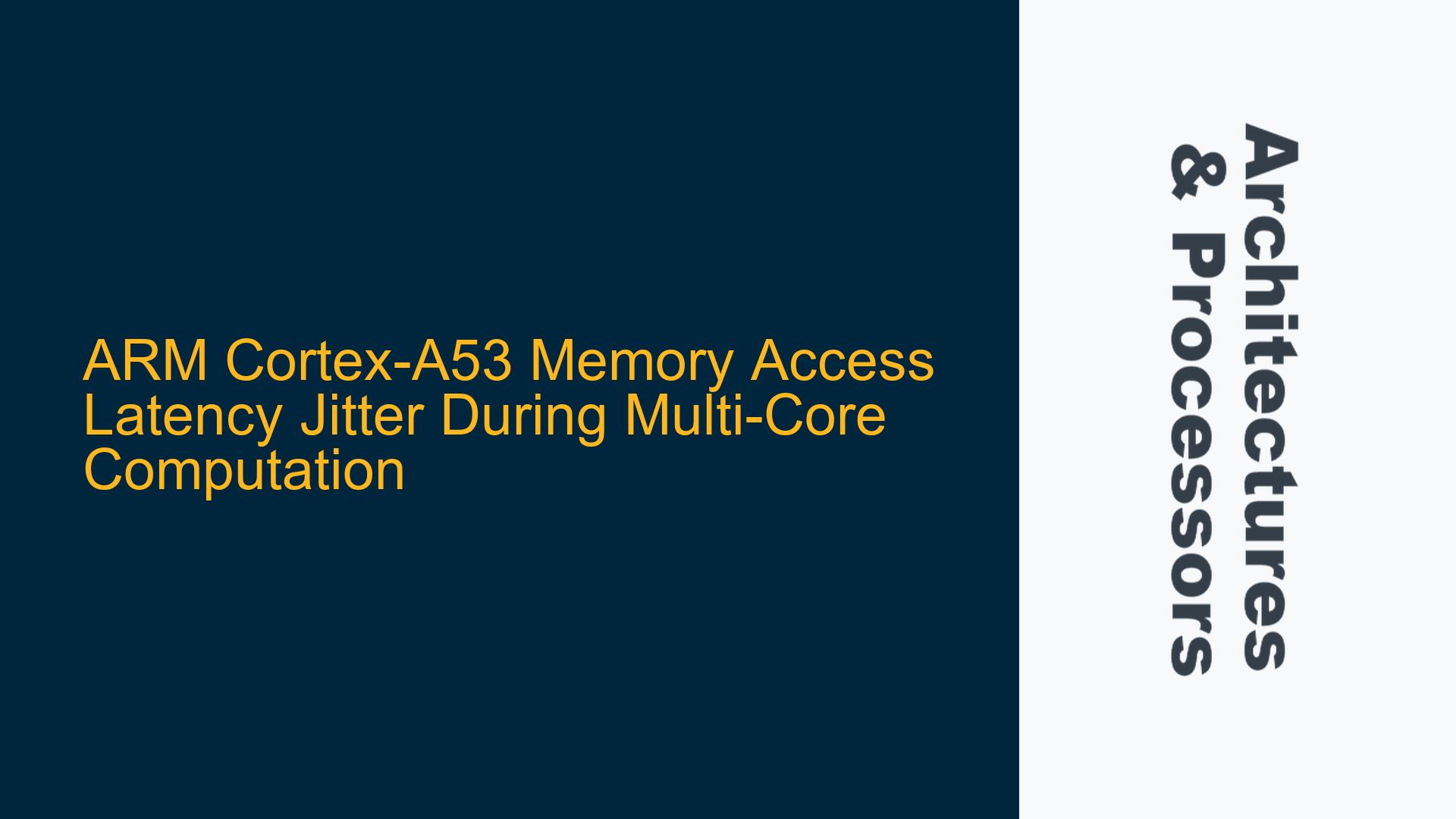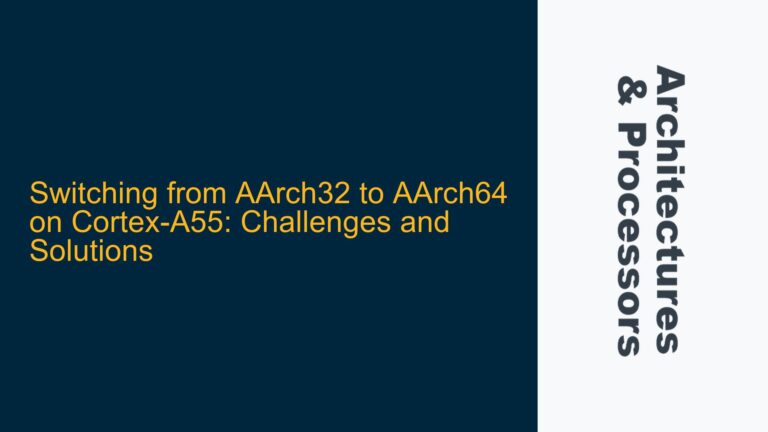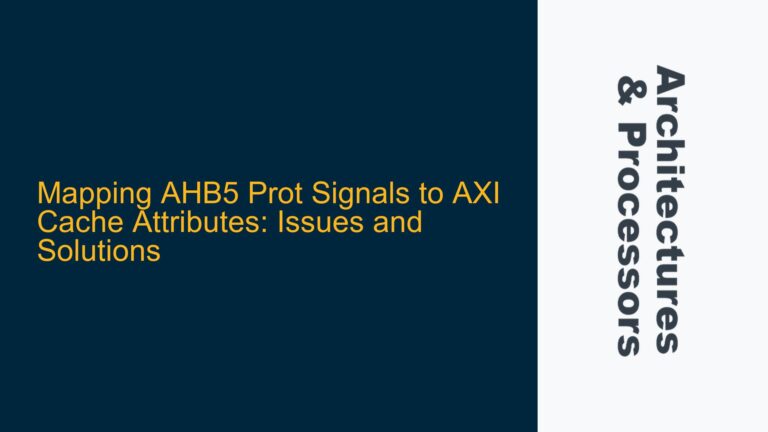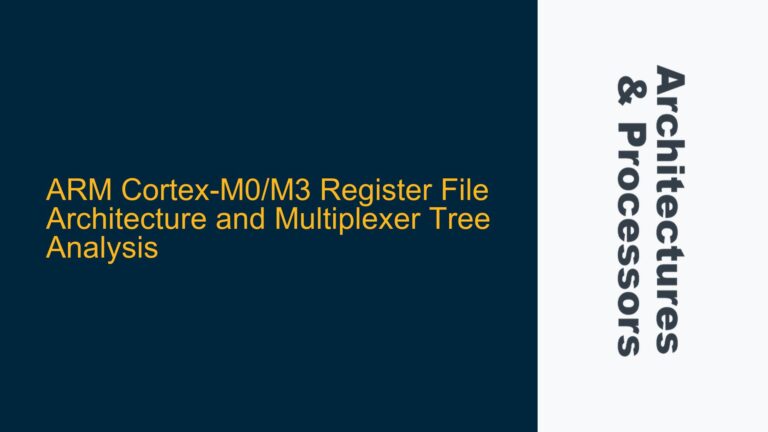ARM Cortex-A53 Cache Contention and Memory Access Latency Variability
The ARM Cortex-A53 is a widely used processor core in embedded systems, known for its balance of power efficiency and performance. However, when executing computationally intensive tasks across multiple cores, particularly those involving large memory arrays, users may encounter significant variability in execution times. This variability, often referred to as jitter, can manifest as a range of execution times for the same operation, such as 90ms to 110ms in the described scenario. This jitter is particularly problematic in real-time or latency-sensitive applications, where consistent performance is critical.
The Cortex-A53 employs a hierarchical memory system, including L1 and L2 caches, to reduce memory access latency. However, when multiple cores are actively accessing shared memory resources, cache contention can occur. Cache contention arises when multiple cores attempt to access the same cache lines simultaneously, leading to increased latency as the cache coherence protocol manages access to shared data. This contention is exacerbated in multi-core systems where all cores are actively processing data, as seen in the quad-core A53 setup.
In addition to cache contention, the Cortex-A53’s memory access latency can be influenced by the operating system’s scheduler and interrupt handling mechanisms. Even minor interrupts or scheduler events can cause cores to temporarily halt execution, leading to idle periods that contribute to the observed jitter. This behavior is particularly pronounced in non-real-time operating systems like Linux, where the scheduler is optimized for throughput rather than deterministic latency.
The issue is further complicated by the fact that disabling cores or reducing the workload on the system can mitigate the jitter, but this is not a viable solution for performance-critical applications. The challenge, therefore, is to identify and address the root causes of the latency variability without compromising the system’s computational throughput.
Cache Coherency Protocol Overhead and Scheduler-Induced Core Idling
The primary contributors to the observed jitter in the Cortex-A53’s memory access latency are cache coherency protocol overhead and scheduler-induced core idling. The cache coherency protocol, which ensures that all cores have a consistent view of memory, can introduce significant overhead when multiple cores are accessing shared data. This overhead is particularly noticeable in workloads involving large memory arrays, where the likelihood of cache line contention is high.
The cache coherency protocol operates by invalidating or updating cache lines across cores whenever a core modifies a shared memory location. This process, while necessary for maintaining data consistency, can lead to increased latency as cores wait for cache line ownership or updates. In a quad-core A53 system, this overhead is amplified, as the probability of multiple cores accessing the same cache lines simultaneously is higher than in a dual-core system.
Scheduler-induced core idling is another significant factor contributing to the jitter. In a multi-core system, the operating system’s scheduler is responsible for distributing tasks across cores. However, the scheduler’s decisions can lead to cores being temporarily idle, particularly if there are no ready-to-run tasks available. This idling can occur even in computationally intensive workloads if the scheduler is not optimized for low-latency task switching.
The impact of scheduler-induced idling is further exacerbated by the presence of interrupts and other system events. Even short interrupts can cause cores to halt execution, leading to idle periods that contribute to the observed jitter. This behavior is particularly problematic in non-real-time operating systems, where the scheduler’s primary goal is to maximize system throughput rather than minimize latency.
Optimizing Cache Usage and Reducing Scheduler-Induced Latency
To address the jitter in memory access latency on the Cortex-A53, several strategies can be employed to optimize cache usage and reduce scheduler-induced latency. These strategies include cache partitioning, memory access pattern optimization, and scheduler tuning.
Cache partitioning involves dividing the cache into separate regions, each dedicated to a specific core or set of cores. This approach reduces cache contention by ensuring that each core has exclusive access to its designated cache region. In the Cortex-A53, this can be achieved through the use of cache coloring or other hardware-based partitioning techniques. By reducing cache contention, cache partitioning can help to minimize the overhead associated with the cache coherency protocol.
Memory access pattern optimization involves restructuring the application’s memory access patterns to reduce the likelihood of cache line contention. This can be achieved by ensuring that each core accesses memory locations that are spatially separated, reducing the probability of multiple cores accessing the same cache lines simultaneously. Additionally, aligning data structures to cache line boundaries can help to minimize the number of cache lines that need to be invalidated or updated during memory accesses.
Scheduler tuning involves modifying the operating system’s scheduler to prioritize low-latency task switching and reduce the impact of interrupts and other system events. This can be achieved by adjusting the scheduler’s time slice duration, prioritizing real-time tasks, and minimizing the frequency of context switches. In Linux, this can be done using real-time patches or by configuring the scheduler to use a real-time scheduling policy.
In addition to these strategies, it is also important to consider the impact of system load on memory access latency. Reducing the overall system load, particularly on the cores responsible for handling interrupts and other system events, can help to minimize the impact of scheduler-induced idling. This can be achieved by offloading non-critical tasks to dedicated cores or by using interrupt coalescing to reduce the frequency of interrupts.
By implementing these strategies, it is possible to significantly reduce the jitter in memory access latency on the Cortex-A53, improving the overall performance and determinism of the system. However, it is important to note that these optimizations may require significant changes to the application’s code and the operating system’s configuration, and should be carefully tested to ensure that they do not introduce new performance bottlenecks.
Conclusion
The jitter in memory access latency observed in the ARM Cortex-A53 during multi-core computation is a complex issue that arises from a combination of cache contention, cache coherency protocol overhead, and scheduler-induced core idling. By understanding the underlying causes of this jitter and implementing targeted optimizations, it is possible to significantly reduce the variability in execution times and improve the overall performance of the system. However, these optimizations require a deep understanding of the Cortex-A53’s architecture and the operating system’s behavior, and should be carefully tested to ensure that they achieve the desired results without introducing new performance issues.






